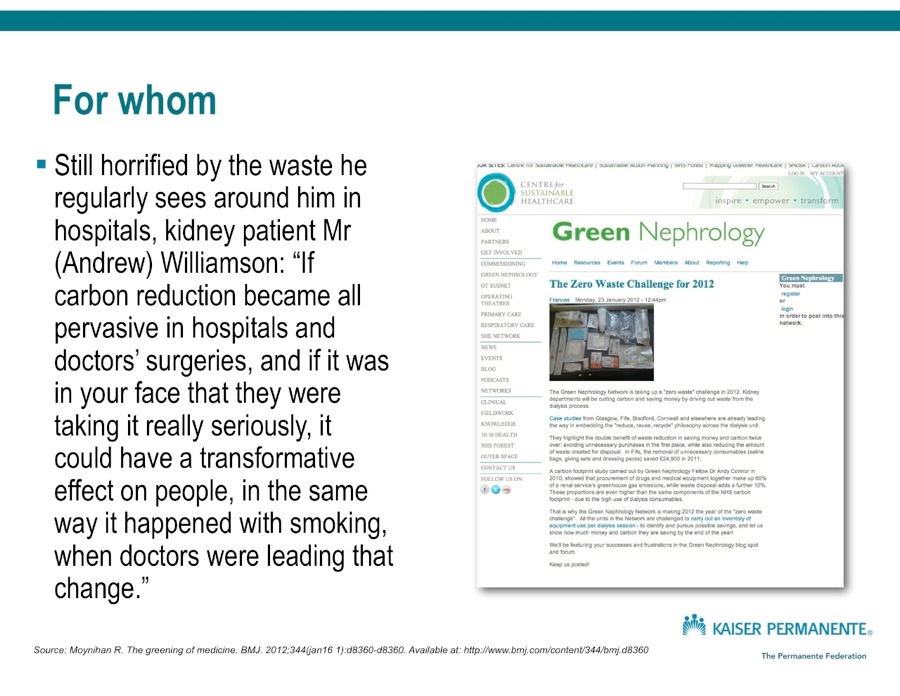Acronyms out of the way: HIMSS12 is the premier Health Information Technology Conference and Exhibition, put on by the Healthcare Information and Management Systems Society. ACPM2012 is the American College of Preventive Medicine’s annual meeting, and the is premier event for professionals in disease prevention and health promotion.. Las Vegas (HIMSS), Orlando (ACPM2012).
Around this time of year I await HIMSS time because the urban centers empty out, the traffic clears, and e-mail traffic abates. The tweets and messages fly as well about who’s going for this huge event. It’s beyond comprehension in my opinion. With the permission of Leonard Kish ( @LeonardKish ), I’m reposting a Twitter DM conversation we had about this.
Our back and forth is a bit tongue in cheek, and I think he’s right, collaboration will have an impact on the “greenness of health care.”
That’s what my talk is about at ACPM2012, and what the next series of blog posts are going to be about, because
- It was a steep learning curve, but one that completely fascinated and drew me in….because,
- I learned in the end that it’s the same conversation that we have about patient empowerment, diversity, and social determinants of health.
- And not only those things above, also health information technology, efficiency, preventive care, and total health…and, it’s measurable
- I think I’m ahead of my time
- I could use help on the narrative that goes with the story before I give the presentation on Feb 22
- I’d like a place to refer people to who ask me if I’m going to HIMSS 🙂
If you are going to HIMSS, Leonard’s eCollaboration Forum is happening there, and you can register for it.
In the meantime I’ll just use the tag #greenhealthcare because my discussion is part of a whole day of experts talking about climate change and health.
Here goes, these slides are not in order, I’ll show a few each day (this is supposed to be 15 minutes), feel free to comment. Let’s start with the patient.
In the medical profession and in health care, we have become numb to the amount of waste we generate. I can remember the first time I scrubbed into a surgery or saw/performed a procedure and saw how much “stuff” we opened, used, and threw away. Some was cleaned, much was not. All in service to the patient.
Our patients aren’t numb, though, as you can tell from the quote above (See: The Greening of Medicine). They are at times horrified, and they want us to lead. And…it turns out all is not needed in service to the patient. From this blog post from the Centre for Sustainable Health Care:
“But everything we use is needed!”
Are you sure? Other units have found that they are opening whole dressings packs but really only needed some gauze swabs, or that a smaller bicarbonate cartridge would do just as well…
In fact, we aren’t sure. The blog post in the slide above (“The Zero Waste Challenge for 2012″“) talks of the significant savings of materials, supplies, money, and CO2 ultimately that comes from making sure. Without compromising performance, this is a way for our patients to see that we want to save their money, their time, and the communities they go back to. And actually, it’s not the communities they go back to, it’s the communities that we share together. Health care is part of the environment, too.
In Green Health care, this extends to the reprocessing of single use devices. Reprocessing of SUD’s (single use devices) is regulated by the Food and Drug Administration, has been extensively studied, and can save enormous amounts of materials, time, money, and…CO2 emissions. The devices are carefully cleaned, recommissioned, tested, and in some cases can perform better than when they were used the first time.
You can read an excellent primer on the reprocessing of single use devices here: Kwakye G, Pronovost PJ, Makary MA. Commentary: a call to go green in health care by reprocessing medical equipment. Academic medicine : journal of the Association of American Medical Colleges. 2010;85(3):398-400.
Reprocessing medical equipment is part of Kaiser Permanente’s target to reduce waste. By 2015, Kaiser Permanente aims to reuse, recycle, or compost at least 40 percent of its waste system-wide, diverting all of this material from landfills. Kaiser Permanente arranged for the safe reprocessing of 274,000 pounds of medical devices in 2010, with a savings of $8 million compared to buying these devices new each time.
Tomorrow, we’ll talk about the safer use of chemicals in health care, then we’ll get to food.


3 Comments
Thanks for the mention Ted! For the record, it’s certainly not “my” eCollaboration Forum. Many people working diligently @CollaborartiveHC (collaborativehc.org) and HIMSS working to make this happen, including: @unclenate @VinceKuratis @rsadams @ydeologi and @drytownlizzie have had critical roles in making this happen, and it may very well have not happened with out the work of every single one of them!
Part of the underlying principles behind the use of platfoms in health care and the development of the eCollaboration Forum are quite simillar to concepts from thermodynamics, so I think it makes perfect sense to think about effectiveness and efficiency on a global scale. See Stephen Johnson’s chapter on platforms in Where Good Ideas Come From http://www.amazon.com/Where-Good-Ideas-Come-Innovation/dp/1594487715 to make far more sense of these concepts than I ever could in a comments, but the basic idea is that there’s really only a few fundamental ways to create value (that all link back to energy consumption of one form or another), and platforms work because they minimize the “transaction costs” and the probablilities of coming together to deliver that value.
I just left a comment in "During HIMSS12 I'll be at ACPM2012 to talk #greenhealthcare – here's why" http://t.co/W55sFQqC
During #HIMMS12 I’ll be w @acpm_HQ #ACPM2012 to talk #greenhealthcare – here’s why http://t.co/iJMpqOd0 #climatechange #sdoh #RxSocial